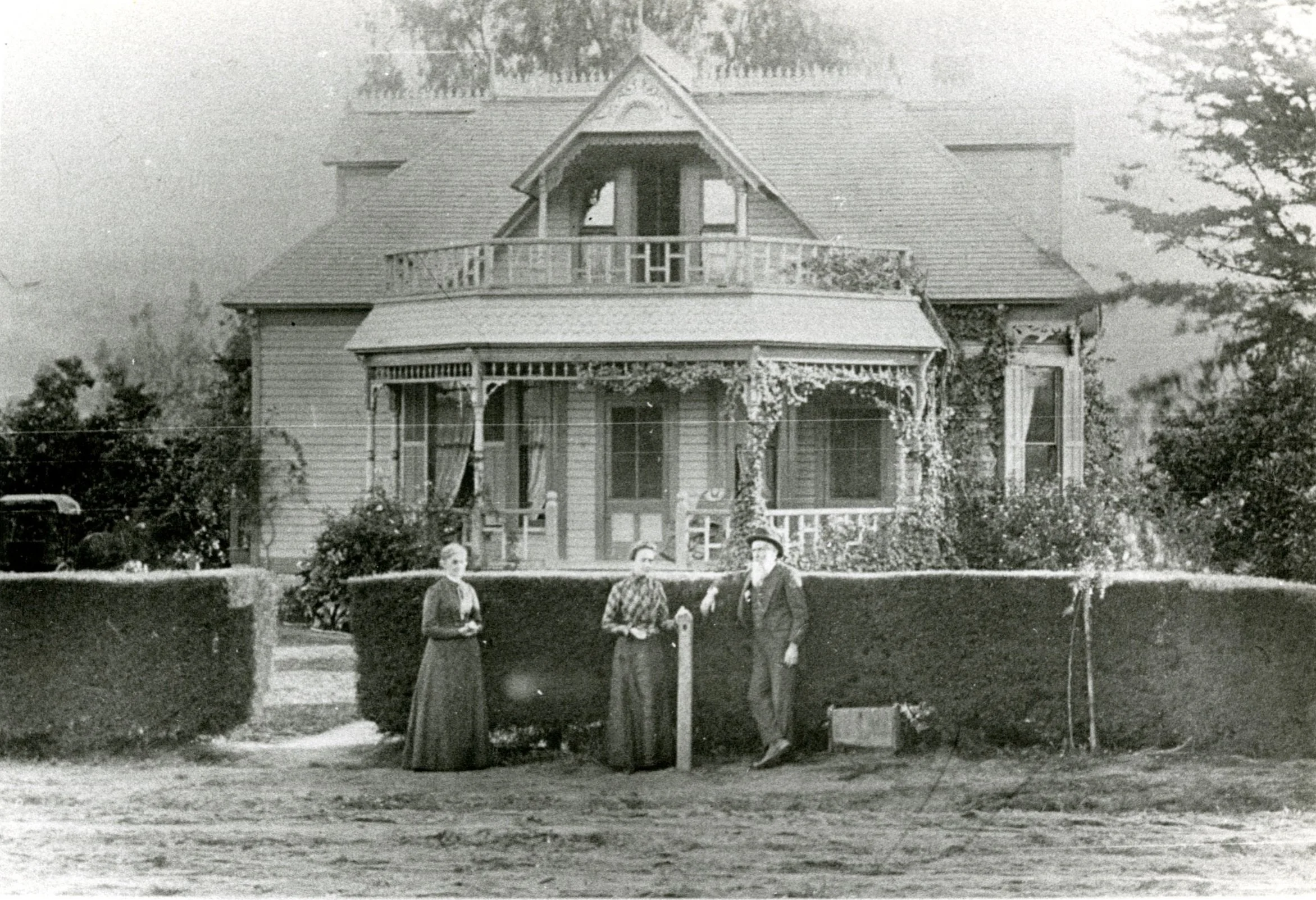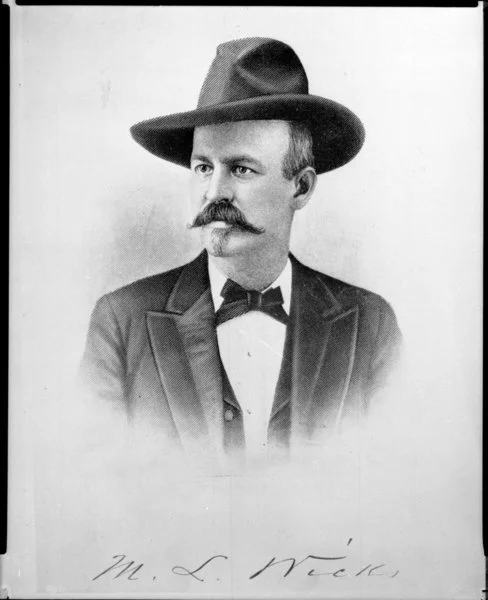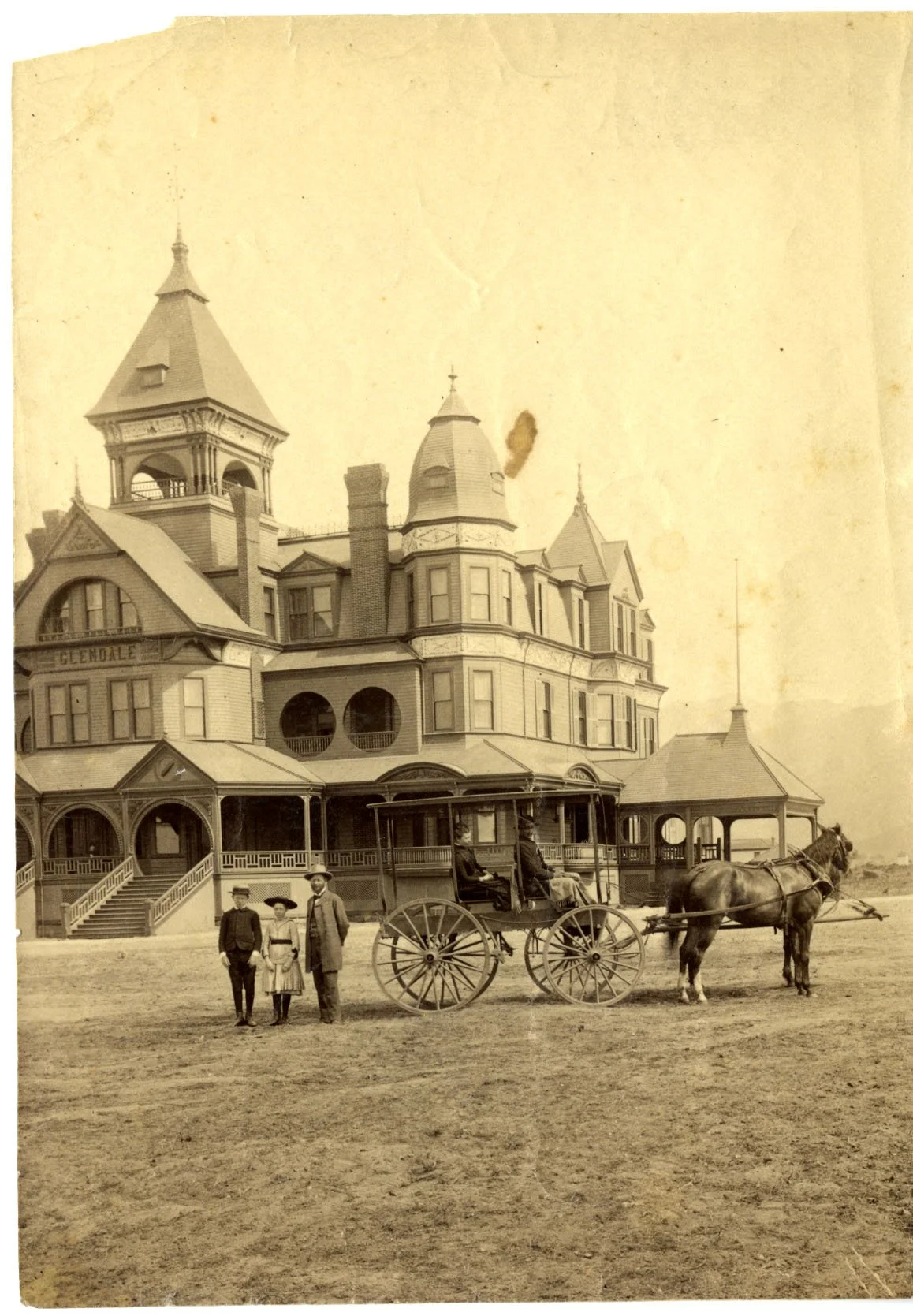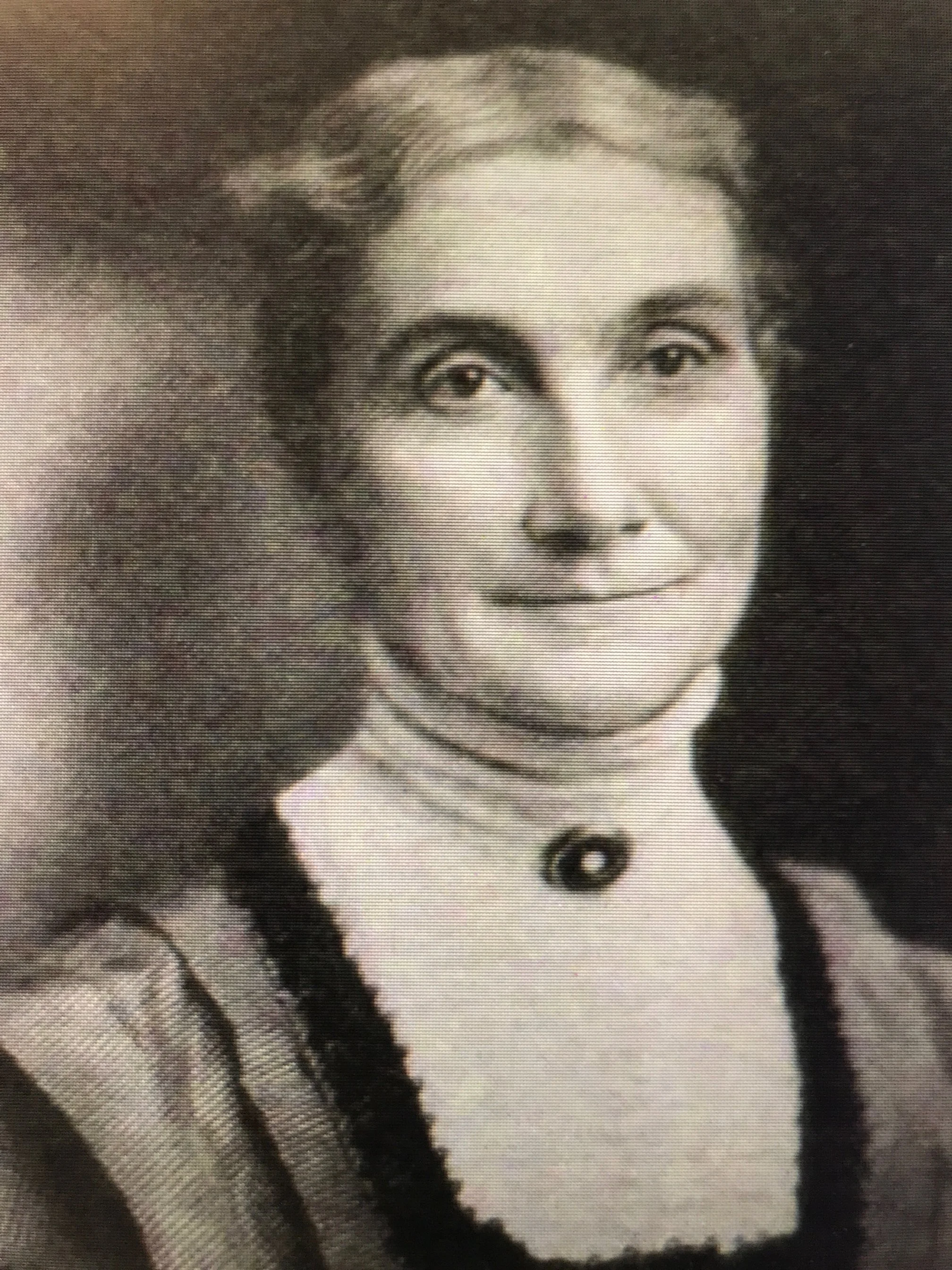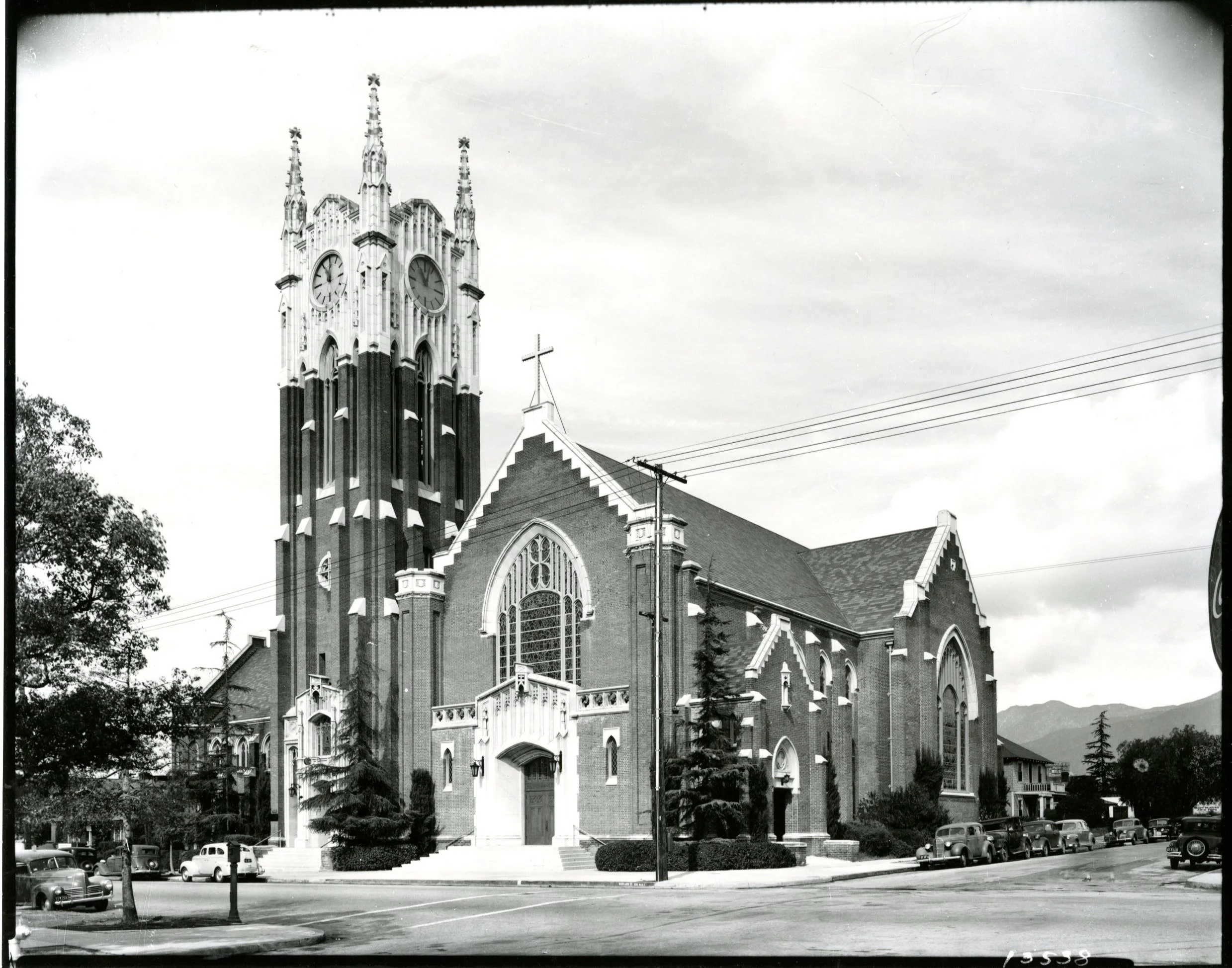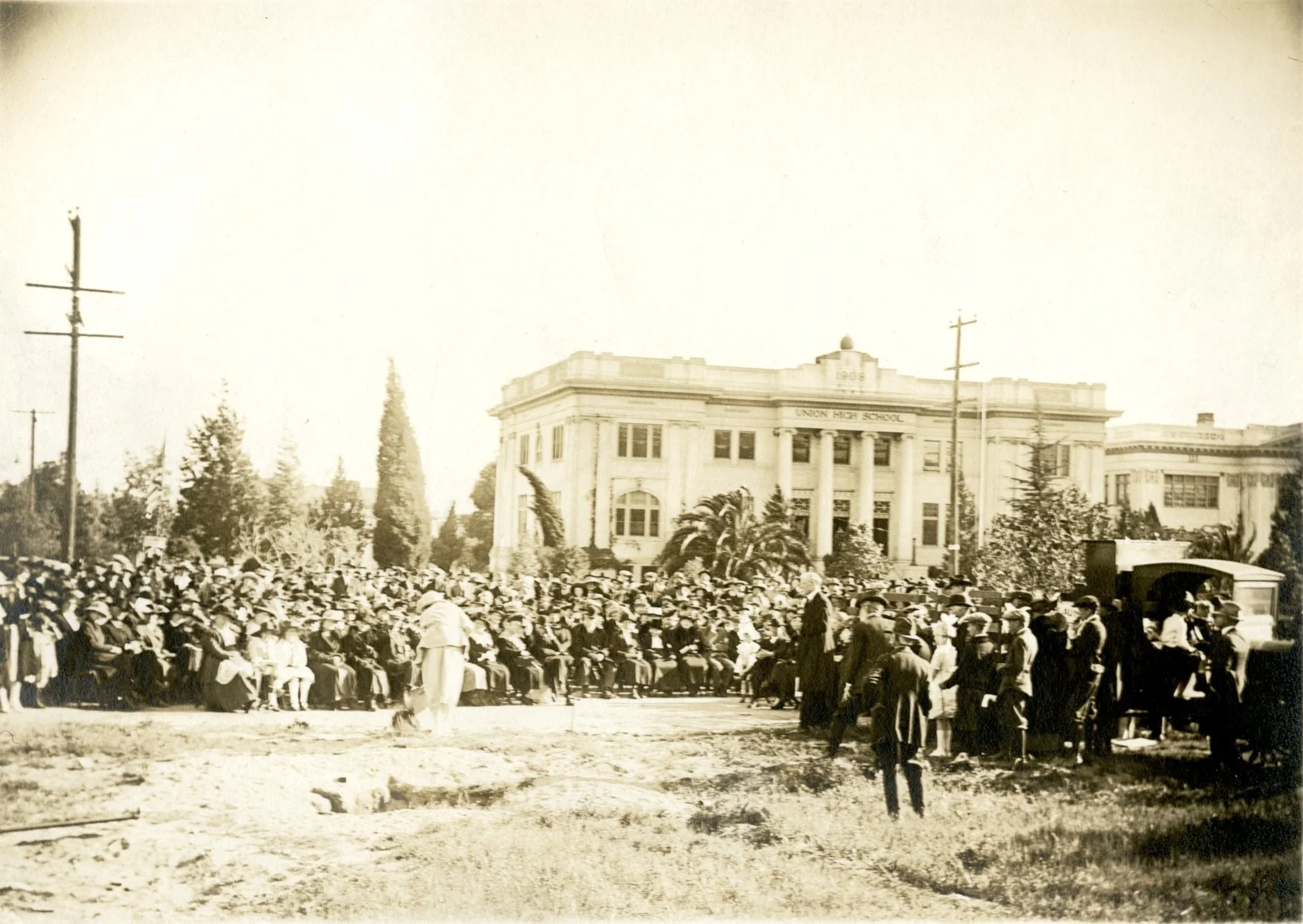STILL STANDING AFTER ALL THESE YEARS
Part IV: Real Estate Speculators, Saloons, the WCTU and the Presbyterians
1880s to 1890s
by Katherine Peters Yamada
Early settlers planted vineyards and orchards. Stone fruit and citrus were popular, but, fruit was “never a profitable business in the valley and those who actually made money were the few who not only produced it, but peddled it as well,’’ as noted in Glendale Area History. Many growers delivered their produce to Los Angeles outlets, where it was often shipped to eastern markets.
Heald ranch house, 1902
Oranges were the primary crop at the Heald Ranch, located in the vicinity of present day Adams Street and Windsor Road. (The people pictured in 1902 have not been identified.) Note the unpaved road in the foreground.
One early landowner was G. W. Benson, who purchased several acres on the east side. He made the newspapers for digging one of the first successful wells in the valley.
S. E. Chase, formerly of Rochester, New York, also owned land on the east side of what is now Glendale Avenue, between Maple Street and Elk Avenue. He purchased his ten acres in 1883. Chase served as a ‘Road Overseer’ and was active in civic events for many years.
Land Speculators
But it seems that real estate speculation was the easiest way to make money. Parcher says that by 1883 most investors were not interested in buying land to plant orchards or vineyards.
M.L. Wicks Credit: USC Libraries Digital Archive
One of the most active speculators was Moses L. Wicks, an attorney with the Los Angeles firm of Wicks, Wright, Hodgkins and Watts. A graduate of the University of Virginia, Wicks had practiced in the South before coming west around 1880. Before setting his sights on Glendale, he laid out the town site of Pomona and also developed Second Street in LA as a crosstown business artery, according to Parcher.
In 1883, Wicks purchased 10,500 acres from Benjamin Dreyfus and others for over $50,000 and then 800 foothill acres from Valentine Mand to gain a share in the all important water rights of the mountain canyons.
That same year, Wicks purchased another property from Valentine Mand. The 500-acre tract, adjacent to the Thom Ranch, included two adobes built by Verdugos: the Rafael Verdugo de Sepulveda Adobe (which later became home to the famed Casa Verdugo Restaurant) and the Verdugo Adobe (now a city park).
J.D. Bliss at his ranch
The portion of the property containing the Sepulveda adobe was eventually sold to George Baugh, a retired Church of England clergyman. In 1900, Baugh sold 360 acres to brothers John and Robert Bliss.
The Bliss brothers built a large Victorian house, painted it yellow and erected stables near the old adobe. They planted fruit trees and kept horses and cows.
Wicks continued to buy and sell. Parcher reports that by the end of 1883, settlers and speculators were arriving in great numbers and that many purchases were made through Wick’s law firm.
Wicks and his second wife, Florence Potts Wicks, resided in the Angelino Heights area of Los Angeles, near Leslie and Mary Loise Brand, who then lived on Douglas Street. The two men were members of a hunting group that met at the Brand residence.
In 1897, Florence Wicks and Mary Loise Brand formed a ladies’ gun club, as reported in the Los Angeles Herald that same year. They met at the Brands every Saturday to practice their marksmanship. The newspaper article noted that the women brought along their dogs: the hostess had four, a pointer and three setters, and Florence had one, a Water Spaniel.
The Ladies of the Women’s Christian Temperance Union and the Presbyterians
Newly built Glendale Hotel
Glendale’s first saloon opened in 1887, but remained open for only three weeks, according to the Glendale Evening News, August 15, 1919. A Denver man had taken took over the ornate Victorian structure built the previous year as the Glendale Hotel. It had closed almost immediately due to financial issues. The unidentified Denver man built a livery stable and put up another small building on the property: it served as a saloon for his employees and other laborers.
But, it seems that the unidentified man was wanted by the law in Ohio. He was soon arrested, the saloon was closed and shortly thereafter the small building burned to the ground. Later, the hotel served as a school.
It seems likely that members of the newly formed Glendale chapter of the Women’s Christian Temperance Union (WCTU), took a stand against the saloon, as the article goes on to say that most of the residents at that time were against the consumption of alcohol.
The chapter had been formed in 1886 as part of a nationwide campaign to restrict the use of alcohol, which leaders felt was the cause of many social problems. Advocating for total abstinence, members across the United States walked the streets of their local towns, stopping in front of saloons to pray and demand that liquor sales stop.
Mrs. O.O. Clarke served as the chapter’s first president, with some 25 members.
Two years later, in 1888, members took action against another proposed saloon. They circulated a petition signed by 185 residents. The petition was successful and the proposed saloon never opened.
Huldah Miller Byram credit: Darlene E. McClain
One early member of WCTU was Huldah Miller Byram. She and her husband Ellis and their five children had lived on a farm in Iowa. When her health began to fail, doctors suggested that she seek a drier climate in California. In 1882, she and three of her children arrived, most likely staying with her father in Los Angeles. There she helped organize the first local chapter of the WCTU, according to Darlene E. McClain’s 125 Years of Glendale Presbyterian Church.
The next year, Ellis Byram and the other two children arrived. He partnered with B.F. Patterson and George Phelon to purchase about 120 acres on the east side of what is now Glendale Avenue. They divided the land into ten-acre tracts. Byram built a two-story house for his family.
There were a few houses and some stores and services here in those early years, but no churches; worshippers had to make the long trip into Los Angeles. Then, several families representing the Presbyterian, Methodist, Baptist and Episcopalian denominations, banded together and found a minister to lead a service on Sunday afternoons in a two-room schoolhouse where Cerritos Elementary now stands.
When the congregation outgrew the schoolhouse, the Presbyterians formed their own church body. It was the first in Glendale, according to George Ellison, formerly of the Glendale History Room at the Central Library.
The Byram family was among those who organized the Presbyterian Church of Riverdale in September 1884. (Byram, one of the men who later filed the plat for the new town of Glendale, was elected as elder of the new church.)
Later that year, the Riverdale Ladies Aid Society organized a supper for 100-plus people. Their $40 proceeds inspired a building project in the 1000 block of what was then Indian Road, now part of Glendale Avenue.
By February 1885, the roof was on and it was partly painted. They changed the name to Glendale Presbyterian Church before it was dedicated. (See photo of church in Chapter II.)
The members soon realized that Glendale was growing faster than Tropico, so in 1888, the sanctuary was moved to new lots donated by Byram and Patterson. (Verdugo Views, Katherine Yamada, February 9, 2002)
Still Standing
Agriculture dominated the landscape in Glendale for many years, but eventually gave way to housing and commercial buildings.
As the new city grew, so did Glendale Presbyterian Church. After several moves, a new and much larger church - with seating for 1300 - was proposed. Plans for the Gothic brick structure called for a 130-foot clock tower, complete with chimes, at the corner of Harvard and Louise Streets. Ground was broken on Easter Sunday, 1922. (Union High School, seen in the background, was just across Harvard St. The Central Library now stands on that site.)
Glendale Presbyterian Church, with clock tower
But the damage inflicted in 1971 by the 6.6 Sylmar earthquake was beyond repair and the entire edifice was demolished. More than a million dollars was needed to finance a new sanctuary and classroom building. The cornerstone from the 1922 church was reinstalled in the new sanctuary, dedicated in 1974.
Groundbreaking, 1922
In 1952, the unreinforced brick structure was badly shaken by the 7.5 Tehachapi earthquake. Two spires broke off of the tower. Repairs and reinforcements were completed by the next year.
Glendale Presbyterian Church, 2022 credit: KPYamada
References
Our local history was studied extensively by early historians, including John Calvin Sherer, who authored ‘History of Glendale and Vicinity’ in 1922. Carroll W. Parcher incorporated much of that information in Glendale Community Book, published in 1957. A later version, Glendale Area History, was published in 1974 and expanded in 1981. Unless otherwise noted, much of what is included here is from these books and from Glendale, A Pictorial History.
Big Orange Landmarks: Exploring the Landmarks of Los Angeles, One Monument at a Time http://bigorangelandmarks.blogspot.com/2009/02/no-217-wicks-residence.html
Casa Verdugo Historic Resources Survey DRAFT City of Glendale, California https://www.glendaleca.gov/home/showpublisheddocument/61486/637508929348170000
Virginia Commonwealth University Libraries, Social Welfare History Project https://socialwelfare.library.vcu.edu/religious/womens-christian-temperance-union/
125 Years of Glendale Presbyterian Church, by Darlene E. McClain, 2009, Glendale Presbyterian Church
L.A. Street Names https://lastreetnames.com/

